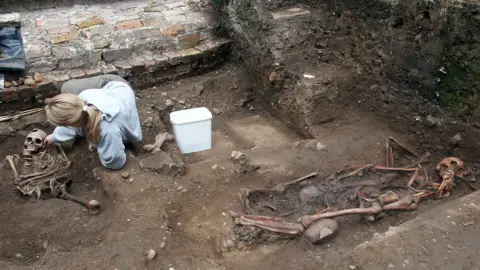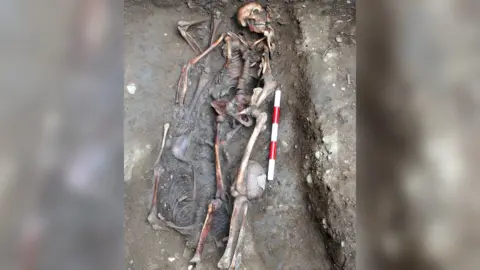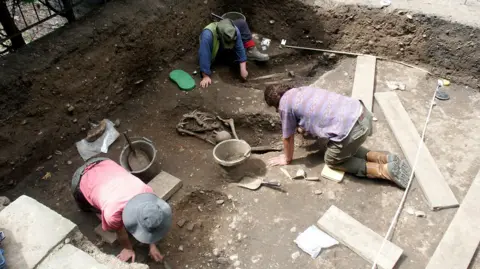Unravelling the tale of a gladiator bitten by a lion
 York Archaeology
York ArchaeologyWhile brand new research into a mutilated skeleton exhumed in York has revealed the first-ever proof of gladiators fighting lions, it was a decision by an archaeologist more than 20 years ago that enabled this buried secret to be discovered in the first place.
The story began in 2004 with a planning application for a development on a street about half a mile (1km) outside the city centre.
As city archaeologist for York Council, John Oxley's job was to assess the potential archaeological impact of allowing flats to be built on a green space on Driffield Terrace.
Given York's importance in the Roman world as a provincial capital and major military base, it was already known the street lay within an area where burials from that time were likely.
Mr Oxley had to ponder whether to object to the plans on the basis that it could potentially disturb any archaeology in the area.
But he instead opted for approval - as long as the developer agreed to pay for underground exploratory work in the hope of uncovering something with research potential.
That vital decision eventually saw the unearthing of a truly remarkable find: a mass graveyard believed to contain the bodies of Roman gladiators who had lived and died in the city.
 York Archaeology
York ArchaeologyMr Oxley reflects: "At the time, it had been 16 or so years since any previous excavation of any Roman burials in York.
"And here we were at Driffield Terrace, with what turned out to be information that was truly astounding."
Roman burial sites in British cities are not unusual, but there were certain features that made this one in York stand out.
Along with more remains found during excavation of a patio at a second site also on Driffield Terrace, some 80 skeletons were excavated - the majority of which were of young, well-built men.
From the evidence of their bones, these men had lived and died violently.
Many of the 1,800-year-old remains showed healed injuries on their heads, faces, fingers and vertebrae, suggesting they had seen a lot of combat.
Some had much stronger muscles in the right arm, a condition noted by Roman writers in slaves trained to fight in the arena.
However, Mr Oxley recalls what was most striking was that at least 46 of the skeletons had been decapitated.
 York Archaeology
York ArchaeologyIn ancient Rome, decapitation, particularly after gladiatorial combat, was a common practice, often used as a final act of fighting.
Mr Oxley explains: "In other Roman cemeteries, you would expect about 5% of inhumations to be decapitated, but this percentage was much, much higher.
"So these decapitations were very, very unusual."
Back in 2004, Mr Oxley would regularly visit the site during the excavation work, which was overseen by York Archaeological Trust.
He reflects: "You were looking at these skeletons, some whose heads had been placed between their knees, or others whose heads had been placed back on their shoulders but facing the wrong way, and you would get this very strong feeling something really unpleasant had happened to them."
He describes the memory of seeing one individual buried with huge iron rings around his ankles.
These shackles, Mr Oxley says, would have been "red hot" when they were likely fixed on him when alive. It was a process which had caused the man injury, given the healed wounds evident on his ankle bones.
"There was this overwhelming sense of horror that not only had this individual undergone this brutal process of having these rings put on, but then he's somehow in a situation where he's either fought to his death or been executed."
 York Archaeology
York ArchaeologyAmong all the skeletons uncovered, there was one which had preserved signs of an especially gruesome death.
This decapitated man, aged between 26 and 35, had various bite marks on his hip, and initial analysis concluded they had been caused by a large carnivore.
While fictional depictions of gladiatorial combat with big cats have featured in historical texts and images, as well as in modern films, the nature and scale of such combat in Roman Britain has been contested.
There was no published evidence to provide direct testimony of such events taking place in the province until the new research based on the find in York emerged last month confirming physical evidence of these beastly battles.
 York Archaeology
York ArchaeologyWhile that gives a new glimpse into life in Roman York, there still remains, tantalisingly, a missing piece in the city's gladiatorial jigsaw - an amphitheatre.
Built as a symbol of power, and to host a variety of public spectacles - most famously gladiatoral fights and public executions - York was large and important enough to have this kind of building.
But so far, no trace of one has ever been found.
Mr Oxley says: "It's unthinkable that York did not have an amphitheatre.
"Although we haven't yet found any evidence, the view of most experts is it's likely to be in the area of the Museum Gardens and Kings Manor."
That theory is based on the placement of amphitheatres found in Chester and Caerleon in south Wales, which, along with York, were major bases for Roman legionaries.
But digging to find that evidence is not easy, Mr Oxley explains.
"Because of its continued importance over 2,000 years, York has always been this centre of power and occupation.
"So, you get these incredibly deep deposits in the city, the Romans being the first ones who are right at the bottom.
"It makes it very difficult to get to the bottom and you'd have to go two to three metres down to find anything."
He adds: "I've been stood in that area so many times and thought, 'oh, if only we can dig and see what's down there'.
"It's incredibly frustrating but, unfortunately, that's archaeology."
Meanwhile, Mr Oxley is modest about the role he played in 2004 which led to the unravelling of new evidence.
"I like to think of it as a relay race," he says.
"Someone in my position is able to set up the opportunity, but you pass the baton on to the archaeologists on site, who then pass it on to other experts down the line.
"The result is that here we are, 20 years later, talking about a site that keeps on giving and feeding our imaginations."
Listen to highlights from North Yorkshire on BBC Sounds, catch up with the latest episode of Look North.
